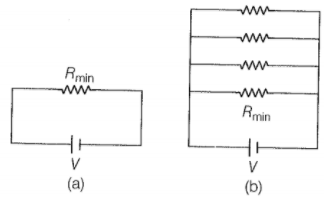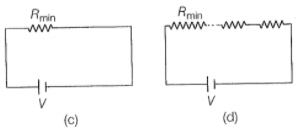Hint: Use the concept of series and parallel combination of resistors.
Step 1:
When all resistances are connected in parallel, the resultant resistance R is given by;
On multiplying both sides by , we have;
Here, in RHS, there exist one term = 1 and other terms are positive, so we have;
This shows that the resultant resistance .
Thus, in parallel combination, the equivalent resistance of resistors is less than the minimum resistance available in a combination of resistors.
Step 2:
Now, in series combination, the equivalent resistance is given by:
Here, in RHS, there exist one term having resistance .
So, we have;
Thus, in a series combination, the equivalent resistance of resistors is greater than the maximum resistance available in a combination of resistors.
Physical interpretation:
In fig. (b), provides an equivalent route as in Fig. (a) for current. But in addition, there are (n-1) routes by the remaining (n-1) resistors. The current in fig. (b) is greater than the current in Fig. (a). Effective resistance in Fig. (b)< . The second circuit evidently affords a smaller resistance.
In Fig. (d), provides an equivalent route as in Fig. (c) for current. Current in Fig. (d)< current in Fig. (c). Effective resistance in Fig (d)>. The second circuit evidently affords a greater resistance.


